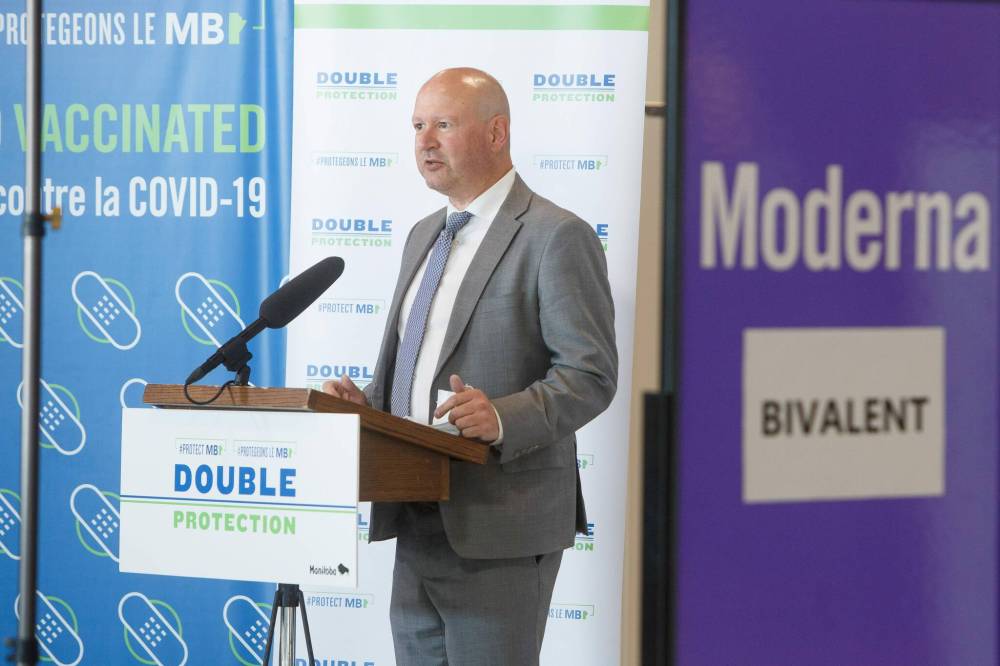New vax messaging could prevent COVID, flu crisis: expert
Advertisement
Read this article for free:
or
Already have an account? Log in here »
To continue reading, please subscribe:
Monthly Digital Subscription
$0 for the first 4 weeks*
- Enjoy unlimited reading on winnipegfreepress.com
- Read the E-Edition, our digital replica newspaper
- Access News Break, our award-winning app
- Play interactive puzzles
*No charge for 4 weeks then price increases to the regular rate of $19.00 plus GST every four weeks. Offer available to new and qualified returning subscribers only. Cancel any time.
Monthly Digital Subscription
$4.75/week*
- Enjoy unlimited reading on winnipegfreepress.com
- Read the E-Edition, our digital replica newspaper
- Access News Break, our award-winning app
- Play interactive puzzles
*Billed as $19 plus GST every four weeks. Cancel any time.
To continue reading, please subscribe:
Add Free Press access to your Brandon Sun subscription for only an additional
$1 for the first 4 weeks*
*Your next subscription payment will increase by $1.00 and you will be charged $16.99 plus GST for four weeks. After four weeks, your payment will increase to $23.99 plus GST every four weeks.
Read unlimited articles for free today:
or
Already have an account? Log in here »
Hey there, time traveller!
This article was published 19/10/2022 (1147 days ago), so information in it may no longer be current.
Heading into flu season with low uptake of bivalent COVID-19 vaccines is a reason to hit refresh on public-health communication in Manitoba, a Winnipeg epidemiologist says.
“Instead of just repeating that vaccines are available for these age groups at these locations, it might be helpful to shake it up a bit,” Cynthia Carr said.
Provincial public-health officials, including chief public health officer Dr. Brent Roussin, should build on the familiarity they’ve forged with Manitobans over the past two years by making public appearances consistently and drawing on results from public-opinion surveys, she suggested. It would help to react to popular beliefs about vaccine effectiveness or mild infections to get ahead of widespread “apathy or confusion” many Canadians feel about the bivalent vaccines now, Carr said.

Chief public health officer Dr. Brent Roussin (above) should build on the familiarity he has forged with Manitobans over the past two years by making public appearances consistently and drawing on results from public-opinion surveys, says epidemiologist Cynthia Carr. (Mike Deal / Winnipeg Free Press)
“It doesn’t have to be about corrections. It’s a conversation. There’s a lot of truth in what people believe. Most of us know many people who’ve had very, very mild COVID. That’s a good thing, but part of it, we have to remember, is because most of us are vaccinated.”
Uptake remains low since the first bivalent doses became available to all Manitoba adults Sept. 22. As of Oct. 8, 3.5 per cent of eligible Manitobans had received a bivalent booster dose, according to the provincial government’s most recent weekly epidemiological report. That percentage amounts to more than 40,000 doses. There were 40,585 doses of Moderna’s bivalent vaccine administered in Manitoba as of Oct. 5, a provincial spokesperson stated.
The specific number of doses distributed to pharmacies across Manitoba hasn’t been publicly released. The bivalent vaccine is available at about 130 pharmacies, medical clinics and vaccine sites in Winnipeg, 15 of which are pop-up clinics taking appointments. The province’s vaccine finder website maps out a total of 375 vaccination sites across Manitoba.
The province is now in the fourth week of its bivalent ad campaign, and has been running advertisements in newspapers, on the radio, on social media and on billboards trying to encourage people to get the shot.
Manitoba may not see a significant increase in uptake unless another crisis hits, Carr said, describing the danger that vaccine campaigns could become a “victim of their own success.”
“That’s always a challenge for vaccination campaigns, is that you get everybody’s attention — whether it’s time, resources and participation — when there’s a crisis,” she said.
“But when things kind of level off or don’t appear to be that scary — even though there’s lots of COVID — people just don’t participate.”
Finding new ways to communicate on social media might improve the province’s reach, Carr suggested, and improve uptake so hospitals aren’t hit with a fall and winter surge of COVID-19 and flu patients at the same time. She said public-health officials should look at responses from Canadian public surveys and give people the data they need, particularly about the prevalence of long COVID and vaccines’ effectiveness in preventing long-term symptoms.
“How are we continuing that conversation? It doesn’t have to be costly, but it does have to be innovative and look at the trust that’s been developed,” she said.
“Refresh the dynamic between government, public health and community members.”
katie.may@winnipegfreepress.com

Katie May is a general-assignment reporter for the Free Press.
Our newsroom depends on a growing audience of readers to power our journalism. If you are not a paid reader, please consider becoming a subscriber.
Our newsroom depends on its audience of readers to power our journalism. Thank you for your support.





